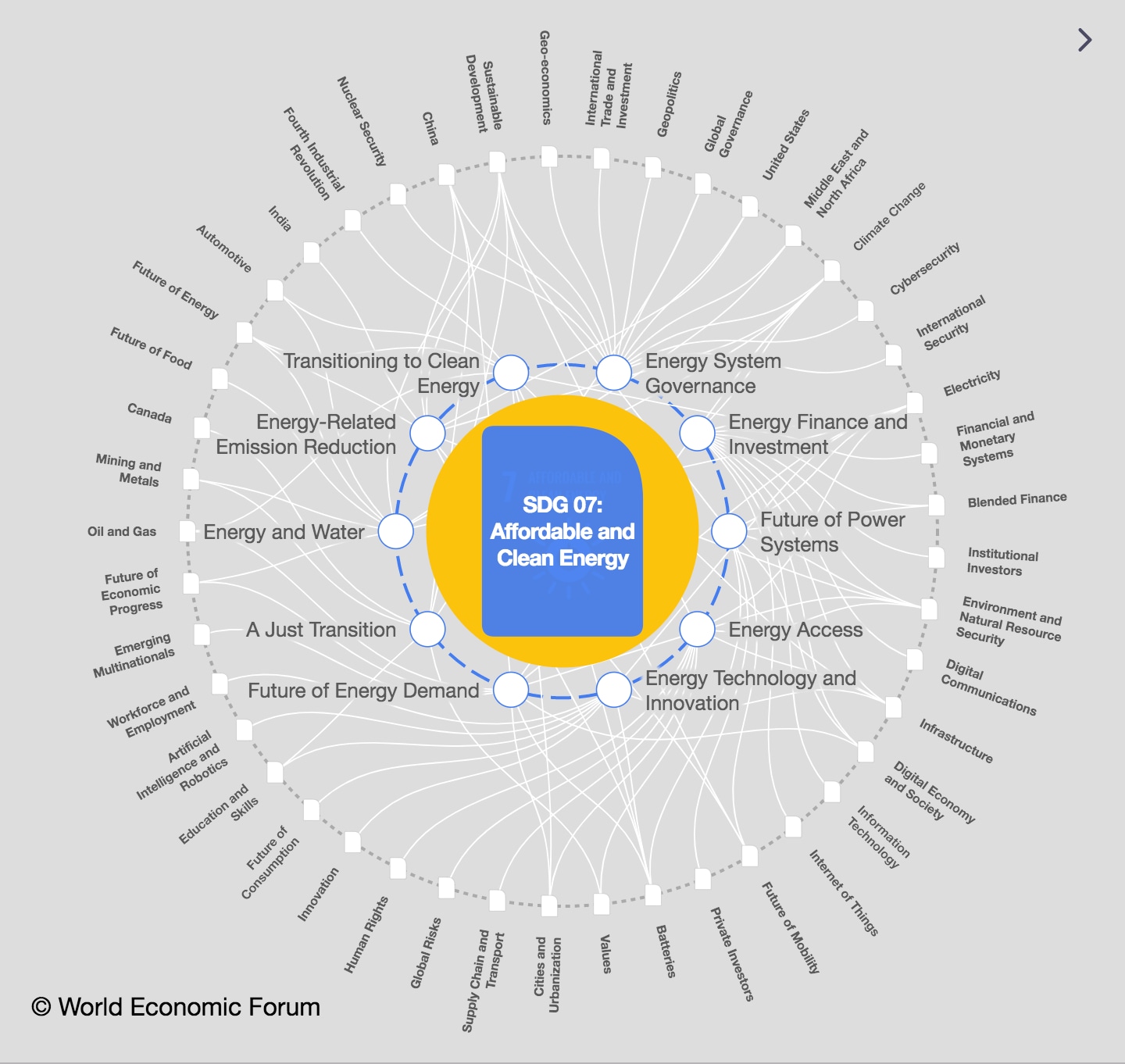Predictions 2022: CEOs and top leaders share tactics that will speed the net zero transition

While energy efficiency is needed to reach net zero targets, we'll need other approaches and solutions for a fossil fuel-free future. Image: NASA
Listen to the article
- Tackling climate change will require new thinking and approaches.
- We'll need a range of innovative approaches and solutions that can scale impact to make a fossil-free future a reality quickly.
- Leaders from top companies explore solutions and approaches that will help drive the net zero transition, including some that might be surprising.
Humanity’s future on planet Earth depends on protecting and restoring nature. Leaders must think innovatively to create solutions that can scale and can effectively tackle our climate goals.
For this special collection, the World Economic Forum reached out to top leaders from companies such as Dow, BASF, Boston Consulting Group and more to share the tactics and strategies that they believe will speed our efforts towards a net zero transition. These mindsets, technologies and approaches show how we will scale change and make true progress for climate action.
What’s the World Economic Forum doing about climate change?
Net zero transition tactic #1: Incentivize - and support - clean hydrogen
The chemical industry has engineered a way to produce clean hydrogen from the by-products from our core production processes. Clean hydrogen would provide a truly circular hydrogen source that will then be used as a fuel in the manufacturing process while the residual CO2 is captured and stored.
Much has been said about the use of hydrogen in manufacturing. And we are seeing a distracting debate about the importance of blue versus green – and other colors of hydrogen - in the transition to a low-carbon economy. While circular is not a color, circular hydrogen is real and most importantly, it’s clean. And for those manufacturers working to eliminate carbon emissions, clean is the goal, and speed to implement matters.
To reach a solution that works, we need broad acceptance of hydrogen as an energy source. This will take the work of policymakers to recognize the potential and draft smart policies that drive technology development and enable cost-effective scale-up of this new fuel. These policies could incentivize, fund, and build the infrastructure needed to broadly deploy hydrogen. They should also promote research partnerships to accelerate innovations in this space, creating more efficient and affordable energy transition. Such policies could support investments in the infrastructure for renewables, H2 and CO2 pipelines, and power grids to activate industrial decarbonization.
-Jim Fitterling, Chairman and CEO, Dow Inc.
"For those manufacturers working to eliminate carbon emissions, clean is the goal, and speed to implement matters."
”
Net zero transition tactic #2: Take pledges and commitments further
There is no shortage of climate pledges and commitments. They are plentiful in areas such as deforestation, land-use change, biodiversity loss or climate justice. But these efforts must be coordinated for the most far-reaching and efficient impact.
Enter partner networks such as the Global Commons Alliance (GCA). This initiative, of which Porticus is a member, brings together leading science organisations, NGOs, businesses and government bodies under one shared vision. The GCA provides a holistic framework to increase engagement, maximize the reach of existing commitments, and monitor progress in preserving our interconnected natural systems.
"Efforts must be coordinated for the most far-reaching and efficient impact."
”We are starting to see the power and impact of the Alliance. At COP26, GCA brought nature to the fore. With its Science Based Targets for Nature framework it devised tangible targets for cities and companies to operate within planetary boundaries by 2030. These science-based targets offer companies and cities competitiveness and resilience by addressing investor concerns, mitigating risk, attracting talent and opening up opportunities to innovate and collaborate, amongst others. Over a hundred companies have already committed to test drive the method. Such an approach can streamline and scale efforts, speeding up the work to meet global climate targets.
- Melanie Maas Geesteranus, CEO, Porticus
Net zero transition tactic #3: Look beyond net zero finance
Global investors are decarbonizing their portfolios and increasingly leaving fossil fuels behind - a positive sign for net zero emission goals. Research from State Street Associates finds that aggregate carbon intensity of institutional portfolios dropped by a third from January 2019 to October 2021. But here’s the rub: simply changing the ownership of brown assets doesn’t do anything to move the world closer to net zero. The answer may lie in what is currently unthinkable for many – staying invested in brown assets to facilitate the transition to green.
Take coal, the world’s single largest source of power, particularly in emerging markets where coal can account for the majority of a country’s electricity production. In that case, the option of switching off coal in the short term isn’t feasible. But in the medium term, the transition away from coal is essential to reduce global greenhouse gas emissions and will require financing.
Rather than procrastination, continuing ownership of brown assets can be part of a genuinely ambidextrous approach to net zero that involves investing heavily in renewable capacity and being responsible owners and creditors of existing hydrocarbon assets as they are wound back.
Given the massive financing need in carbon intensive emerging markets, it’s hard to see an alternative to a collaborative approach to financing the transition to net zero.
-Rick Lacaille, Global Head of ESG, State Street Corporation
"It’s hard to see an alternative to a collaborative approach to financing the transition to net zero."
”Net zero transition tactic #4: Embrace new approaches to collaboration
Many business leaders have historically underestimated the speed — and overestimated the cost — of new green technologies. In the energy sector, for example, solar, wind, and electric vehicle technologies were all developed faster and more economically than originally predicted.
It’s critical to not be caught off guard and to seize significant opportunities as climate innovation brings a level of disruption that will challenge the fundamentals of many traditional business models. One of the most effective ways to make a powerful impact in green innovation is for leaders to adopt a partnership approach.
"Companies - and humankind - have only a short window to succeed."
”Breakthrough Energy Catalyst, part of Bill Gates’s umbrella organization Breakthrough Energy, is an exciting example. This new coalition of businesses, governments, philanthropies, and individuals will accelerate next-generation climate technologies through direct investments aimed at funding the early deployment of decarbonization technologies. The initial focus is on green hydrogen, long duration energy storage, direct air capture, and sustainable aviation fuel – technologies that are essential to reducing the “green premium” and supporting a net zero economy.
Catalyst should serve as a model for the kinds of partnerships that are needed to accelerate the transformation to net zero. As leaders seek to pivot their organizations to new businesses and technologies, engaging with partners across the private and public sectors will increase the likelihood of success and decrease the time it takes to get there, while companies — and humankind — have only a short window to succeed.
- Christoph Schweizer, CEO, Boston Consulting Group
Net zero transition tactic #5: Embraced standards and methodologies
To protect the climate, we must adapt the way we travel, heat our homes, eat, or take purchasing decisions. But understanding how our actions can make an impact isn’t always easy. Despite ISO norms, there are no sufficient standardized specifications to determine product carbon footprints (PCFs) for individual products. In the absence of such detailed rules, PCFs of the same products from different companies cannot yet be fully compared.
"Only with the correct information at hand can we take effective action."
”To help customers better understand the impact of choosing one product over another, we at BASF developed a powerful digital solution to calculate the cradle-to-gate product carbon footprints (PCFs) for our 45,000 sales products. The result? We learned that calculating the PCFs for chemical products is complex, but feasible – with the help of trustful emission data, an unbiased calculation methodology, and a powerful digital solution. The data also provides insights that help identify emission reduction potentials.

In essence, industries will need to align on shared methodologies and manufacturers will need to embrace the principle to share their product carbon footprint data with their partners along the value chain. Our BASF contribution to this: We made our digital solution available in the market by licensing it to software houses. They are now supporting other companies in determining the carbon footprint of their products and in better understanding their emission drivers. At the same time, we are actively engaged in numerous industry and cross-industry consortia to foster the alignment on a common lifecycle assessment methodology as well as to establish data exchange mechanisms and platforms. Because only with the correct information at hand can we take effective action.
-Dr. Martin Brudermüller, Chairman of the Board of Executive Directors of BASF SE
Don't miss any update on this topic
Create a free account and access your personalized content collection with our latest publications and analyses.
License and Republishing
World Economic Forum articles may be republished in accordance with the Creative Commons Attribution-NonCommercial-NoDerivatives 4.0 International Public License, and in accordance with our Terms of Use.
The views expressed in this article are those of the author alone and not the World Economic Forum.
Stay up to date:
SDG 07: Affordable and Clean Energy
Related topics:
Forum Stories newsletter
Bringing you weekly curated insights and analysis on the global issues that matter.
More on Energy TransitionSee all
Ginelle Greene-Dewasmes
November 18, 2025






